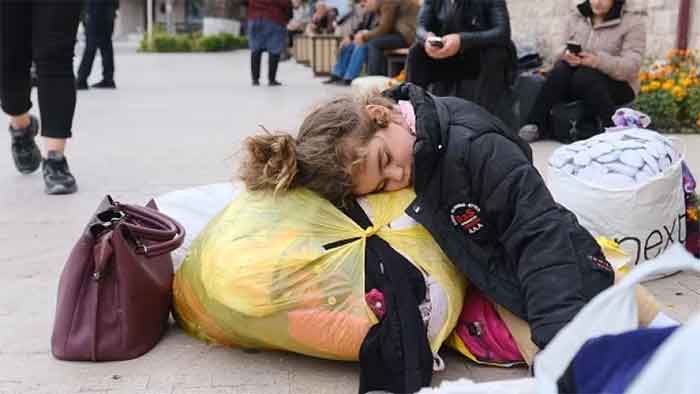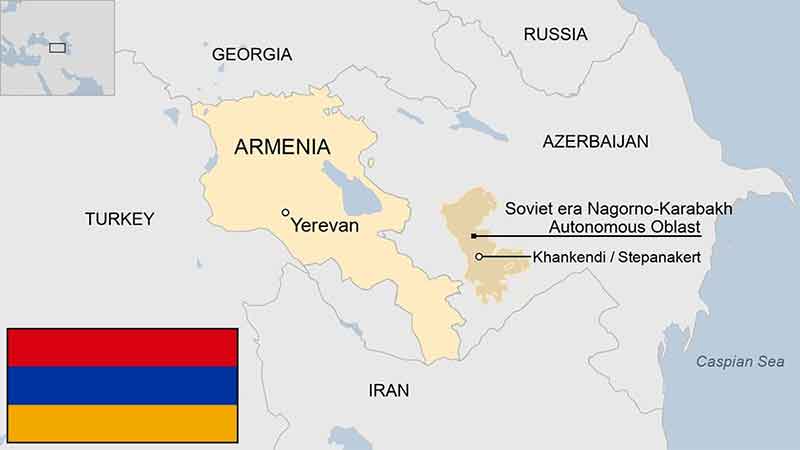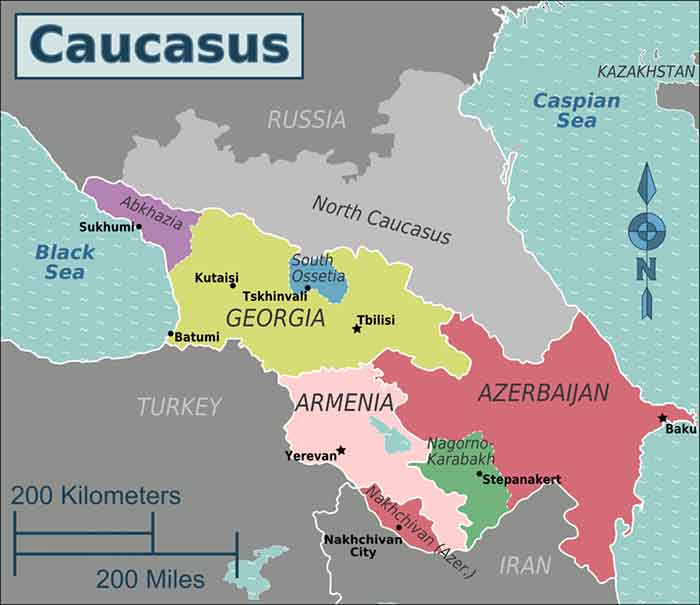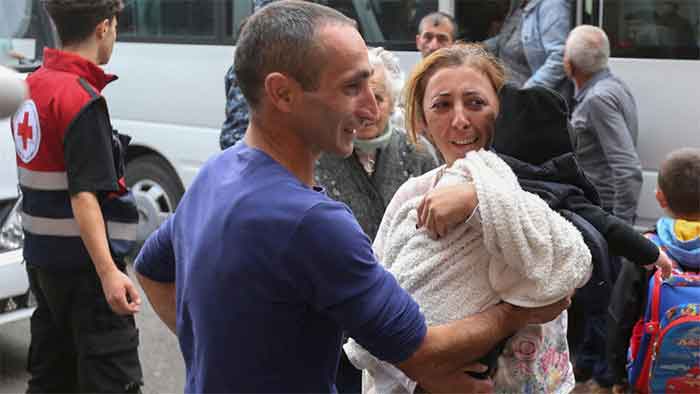
At least 28,000 Armenians have fled the disputed Nagorno-Karabakh region since September 20, when Azeri forces attacked Armenian forces and Russian peacekeepers in the enclave and forced Armenian troops to surrender. A considerable portion of Nagorno-Karabakh’s 120,000 population has been turned into refugees.
Coming amid NATO’s war with Russia in Ukraine, the fratricidal war between the two former Soviet republics of Armenia and Azerbaijan is yet another disastrous consequence of the nationalist Stalinist bureaucracy’s dissolution of the Soviet Union in 1991. A first Azeri-Armenian war over Nagorno-Karabakh began in 1989 and lasted until 1994, resulting in an Armenian conquest of the region. Amid the NATO-Russia war in nearby Ukraine, this war is re-erupting again.
Already in 2020, Azeri forces armed with drones and backed by Turkish President Recep Tayyip Erdogan dealt a defeat to Armenian forces who controlled the Nagorno-Karabakh. Since June, Azeri President Ilham Aliyev blockaded Nagorno-Karabakh, closing off its land transport routes and cutting off its access to food and medicine imports. Last week, Azeri forces rapidly struck Armenian forces and, after one day of fighting, compelled a rapid surrender.
Tens of thousands of Armenian civilians are fleeing Nagorno-Karabakh, amid unconfirmed reports that Azeri troops are bombarding villages and control part of the capital, Stepanakert (Khankendi in Azeri). On Monday, in a further tragedy, a fuel depot in Stepanakert exploded, surrounded by civilian cars trying to get fuel to flee to Armenia. At least 68 people were killed and 290 injured in the blast, many of them with serious burns, which cannot be treated in the blockaded enclave.
Azeri officials have denied that they are attacking civilian areas, but civilians fleeing to Armenia told international media they faced horrific conditions. Petya Grigoryan, a 69-year-old driver who has fled to Armenia, told Reuters that Azeri forces bombarded his village, Kochogot, and that there were “truckloads” lying dead in the street. “There was nowhere to bury them,” Grigoryan said. “We took what we could and left. We don’t know where we’re going. We have nowhere to go.”
Nairy, a builder, fled the village of Shosh with his family after it was shelled by Azeri troops. “The kids were injured. We sat in the basements until the peacekeepers came in and took the people out,” he told Reuters. He and his family fled to the Stepanakert airport, where thousands were sleeping outside. “We are extremely grateful to the lads for sharing their rations with the kids,” he said. “The Russian peacekeepers went hungry to give the kids their rations.”
Narine Shakaryan said she and her family had fled in her son-in-law’s car, taking 24 hours to make the a 77-kilometer (48-mile) drive to Armenia, without food. “The whole way, the children were crying, they were hungry,” she said. “We left so we would stay alive.”
Azeri troops also fired on Russian forces who were stationed in Nagorno-Karabakh as peacekeepers after the 2020 war. According to Russian military sources, five men, including Captain First Rank Ivan Kovgan of the Russian North Fleet, were killed. Azeri officials have stated that this was a mistake, and have pledged a joint investigation of the killings with Russian prosecutors.
The disaster unfolding in Nagorno-Karabakh is inseparable from the broader plunge of the former Soviet Union into fratricidal war like the current war between Russia and Ukraine. It is the poisoned product of both the nationalism of the Soviet bureaucracy and its false, Stalinist theory of building “socialism in one country,” and the imperialist powers’ decades-long waging of wars in the Middle East and Central Asia in the post-Soviet era.
The major capitalist governments are focused not on preventing massacres or keeping civilians from being expelled from their homes, but on using the crisis to improve their strategic position in the war. This begins first of all with US imperialism, which aims to detach Armenia, under pro-NATO President Nikol Pashinyan, from its traditionally close ties to Russia and Iran.
Pashinyan has responded to the Armenian military debacle by denouncing Russia. “As a result of the events in Ukraine, the capabilities of Russia have changed,” he said, adding, “All of this … was supposed to be in the sphere of responsibility of Russian peacekeepers and as far as these issues exist, the Russian peacekeepers have failed in their mission.”
On Tuesday, Pashinyan greeted US Agency for International Development (USAID) chief Samantha Power in the Armenian capital, Yerevan, where she issued an appeal to the conscience of Azeri President Ilham Aliyev. She called on Aliyev to “maintain the ceasefire and take concrete steps to protect the rights of civilians in Nagorno-Karabakh.” She also proposed an “international monitoring mission” to the region.
Power’s cynical rhetoric is not aimed at helping civilians or swaying Aliyev, whose regime aims to conquer Nagorno-Karabakh and boasts that Aliyev is building an “iron fist” to control it. Rather, Power aims to establish a broader NATO influence on Russia’s borders, near key war theaters in Ukraine.
Indeed, the Caucasus is not only rich in valuable natural resources, but also strategically located near the areas of Russia bordering Crimea and Ukraine. A NATO strategic and military presence in the Caucasus would strengthen NATO in preparation for launching a war directly with Russia.
On Monday, Erdogan traveled to meet Aliyev in Nakhchivan, an autonomous land-locked enclave of Azerbaijan bordering Turkey, Armenia and Iran. Erdogan hailed the victory of Azeri troops in Nagorno-Karabakh, in what Aliyev claimed was an “anti-terrorist operation.” Erdogan cynically declared: “It’s a matter of pride that the operation was successfully completed in a short period of time, with utmost sensitivity to the rights of civilians.”
Erdogan and Aliyev also signed a deal for a joint gas pipeline to bring Azeri gas to Turkey through the areas contested by Armenia and Azerbaijan. In the weeks preceding Azerbaijan’s latest offensive, the Turkish and Azeri governments had raised the opening of the “Zanzegur corridor.” This is a plan, opposed by Armenia, to connect Azerbaijan to Nakhchivan and Turkey by taking control of a road passing through Armenian territory.
Erdogan said, “We will do our best to open this corridor as soon as possible. The realization of this corridor, which is very important for Turkey and Azerbaijan, is a strategic issue and must be completed.”
Also on Monday, US State Department spokesman Matthew Miller echoed Pashinyan’s remarks, stating that the war shows Russia is too weak to defend Armenia. “I do think that Russia has shown that it is not a security partner that can be relied on,” Miller said, calling for an “international mission” to the Caucasus.
Russian Ambassador to the US Anatoly Antonov replied by accusing Miller of aiming to “inflict strategic damage on Russia” and “push us out of the region.”
The influential Center for Strategic and International Studies think-tank in Washington D.C. declares that the Armenian-Azeri conflict gives NATO the chance to replace Russia as the strongest military power in the Caucasus. It writes:
“Russia’s full-scale invasion of Ukraine in 2022 has weakened its ability to effectively control and interfere in the decades-long conflict … This has created opportunities for other external actors—including Turkey, Israel, and Iran—to promote their own interests and agendas in the region. The renewed Azerbaijani offensive against Karabakh Armenians reflects these changing power dynamics, providing Western policymakers with an opportunity to step up as potential guarantors of longer-term peace and stability in the Caucasus—a title famously claimed by Russia.”
Halting the war spiral requires unifying the working class in the ex-Soviet Union and internationally in a Trotskyist struggle for socialist revolution against imperialism and Stalinism. NATO’s escalating war on Russia precludes any peaceful resolution of the bloody ethnic conflicts that emerged from the dissolution of the Soviet Union. This requires building an international, socialist movement in the working class against imperialisn, war and the corrupt capitalist regimes that emerged from the Stalinist restoration of capitalism in the Soviet Union.
Originally published in WSWS.org














































